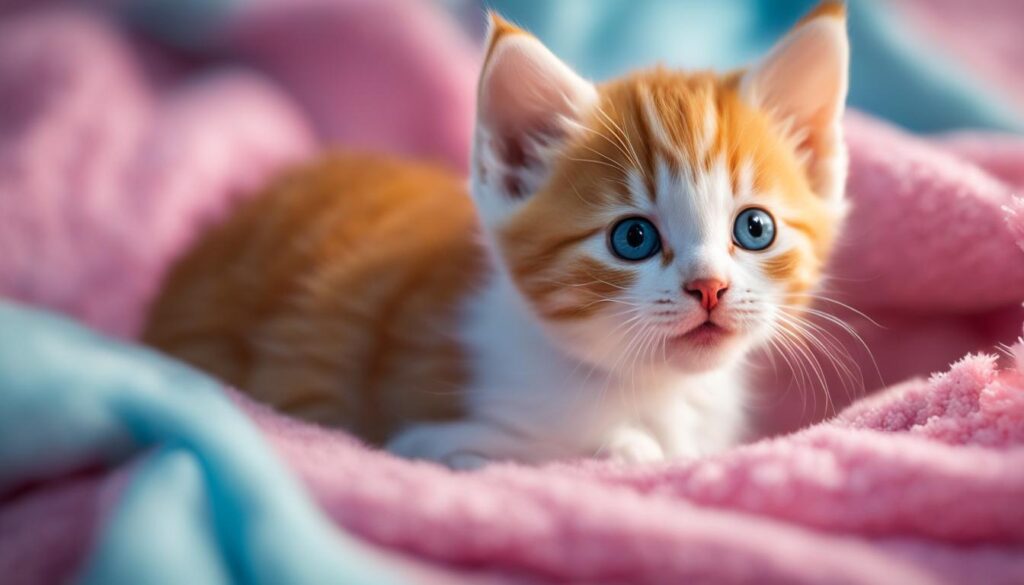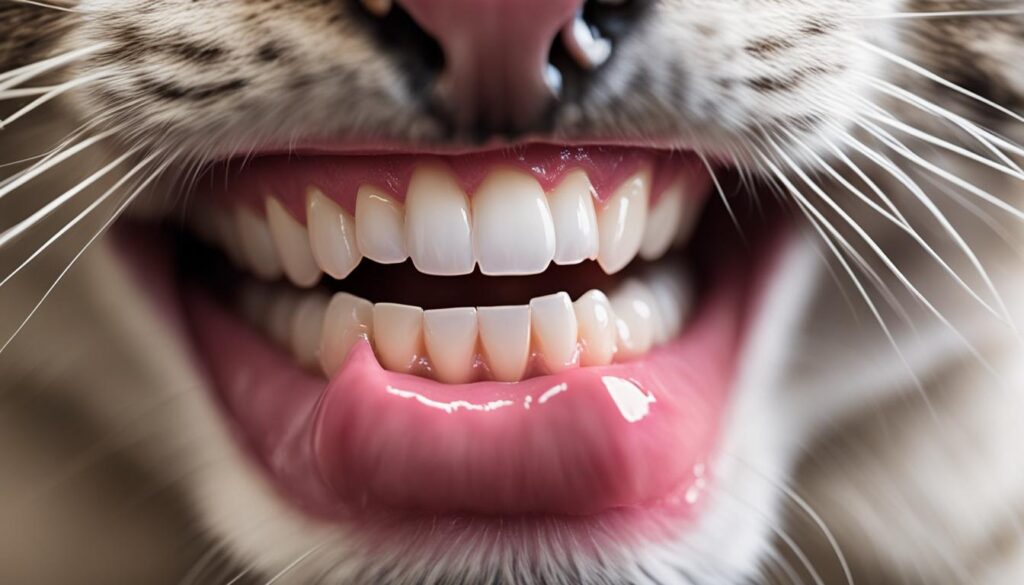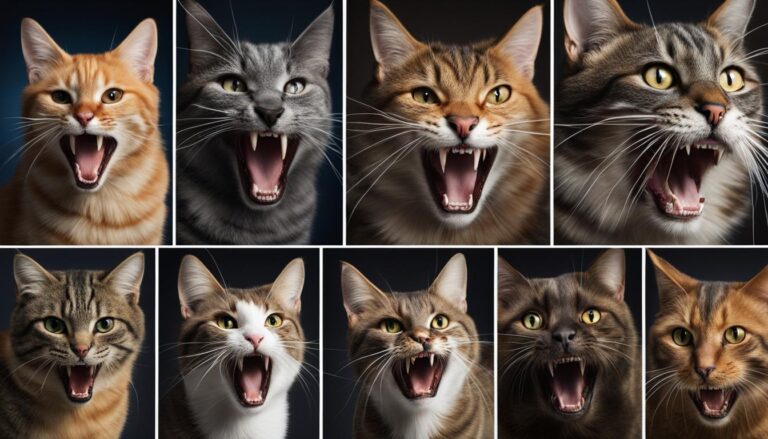Have you ever wondered about the dental structure of cats? How many teeth do they have and what is their anatomy like? Understanding the dental health of your feline friends is essential for their overall well-being. Let’s dive into the fascinating world of cat teeth and explore their anatomy and importance in detail.
Principales conclusiones:
- Cats have two sets of teeth: deciduous (baby teeth) and permanent teeth.
- They start with 26 temporary milk teeth that fall out within four months.
- Adult cats have a total of 30 teeth, including incisors, canines, premolars, and molars.
- Maintaining proper dental hygiene is crucial for preventing dental problems in cats.
- Neglected dental care can lead to plaque buildup, tartar formation, and periodontal disease.
The Astonishing Anatomy of Cat Teeth
When it comes to the dental structure of cats, their anatomy is truly astonishing. Cats have two sets of teeth: deciduous and permanent. The deciduous teeth, also known as milk or baby teeth, appear around three weeks after birth. These temporary teeth serve their purpose for a short period of time and eventually fall out within four months, making way for the permanent teeth.
Adult cats have a total of 30 teeth, consisting of different types. In the front of their mouth, they have incisors, which are small, sharp teeth used for nibbling and grooming. On the sides, there are canines, which are long and pointed, allowing cats to grasp and tear their food. Behind the canines, there are premolars and molars, which have flat surfaces that help in grinding and chewing. This combination of teeth is essential for cats to successfully consume their prey and maintain their overall wellbeing.
Comprender la feline dental structure is crucial for cat owners to ensure proper care for their furry friends. By regularly examining their cat’s teeth and gums, pet owners can detect any abnormalities or signs of dental problems early on. Maintaining a good oral hygiene routine, which includes brushing their cat’s teeth, can help prevent issues such as plaque buildup, tartar formation, and periodontal disease.
The Astonishing Anatomy of Cat Teeth
| Teeth Type | Number of Teeth |
|————|—————-|
| Incisors | 12 |
| Canines | 4 |
| Premolars | 10 |
| Molars | 4 |
Table: Number of teeth in a cat’s dental structure.
Adorable Kittens Losing Baby Teeth
During their early months of life, kittens go through a teething phase that marks an important milestone in their dental development. Around three to nine months old, their baby canines, also known as deciduous teeth, are gradually replaced by permanent ones. This process, known as kitten teething, can be a fascinating and adorable sight to witness as tiny teeth make their way into the world.
As kittens go through teething, they may experience discomfort and tenderness in their gums, which can lead to increased chewing and biting behavior. You may notice your kitten chewing on various objects or even your fingers as they seek relief from the teething process. It’s essential to provide appropriate teething toys and encourage positive chewing habits during this stage to prevent damage to furniture or other belongings.
It’s important to note that the teething phase varies from kitten to kitten, and not all cats lose their baby teeth at the same time. Some kittens may start losing their deciduous teeth earlier than others, while some may retain them for a little longer. It’s always a good idea to consult with your veterinarian if you have any concerns about your kitten’s dental development or if you notice any abnormal changes.
| Age | Descripción |
|---|---|
| 3 weeks | Deciduous teeth begin to appear |
| 3-9 months | Kitten teething phase |
| 4-6 months | Deciduous teeth start to fall out |
| 6 months | Adult teeth fully developed |
Remember, kittens go through various stages of development, and losing their baby teeth is just one part of the process. It’s essential to provide them with a balanced diet and proper dental care as they transition to their adult teeth. By taking care of their dental health early on, you can help set the foundation for a lifetime of strong, healthy teeth and gums.

The Conjuring of Kitten Teeth
When it comes to the development of their teeth, kittens go through a fascinating process. It all starts with tooth buds, which are located in their gums. These tooth buds house the developing adult teeth, which gradually grow until they are ready to emerge. This process of tooth development is an intricate dance between nature and biology.
As kittens grow, their deciduous teeth, also known as baby teeth or milk teeth, begin to fall out. This process is similar to human children losing their baby teeth. The baby canines are the first to be replaced by their permanent counterparts, followed by the rest of the deciduous teeth. It’s common to find these tiny teeth scattered around the house during this teething phase.
Once the baby teeth have been shed, the permanent adult teeth take their place. Cats have a total of 30 teeth, including incisors, canines, premolars, and molars. These teeth serve various functions, such as biting, tearing, and grinding food. It’s important to note that the process of tooth development and replacement varies slightly between individual kittens, but the general pattern remains the same.
| Type of Tooth | Number in Kittens | Number in Adult Cats |
|---|---|---|
| Incisors | 12 | 12 |
| Canines | 4 | 4 |
| Premolars | 12 | 10 |
| Molars | 4 | 4 |
Understanding the development of kitten teeth and the number of teeth they have is essential for cat owners. It allows them to monitor their kittens’ dental health and ensure proper care. Regular check-ups with a veterinarian and providing appropriate dental hygiene are crucial in maintaining the overall well-being of these adorable feline companions.
The Dynamic Dance Between Teeth and Gum
Maintaining proper oral hygiene is crucial for cat dental health. Just like humans, cats can experience dental problems that can impact their overall well-being. Regular care and attention to your cat’s oral hygiene can help prevent dental diseases and ensure they have a healthy mouth.
Cats develop a complete set of permanent molars around six months old. These molars play a vital role in chewing and grinding food. Neglecting dental hygiene can lead to plaque buildup, tartar formation, and periodontal disease. Plaque, a sticky film composed of bacteria, can accumulate on the teeth and harden into tartar if not removed. This can create an ideal environment for bacteria to multiply and cause gum inflammation.
Periodontal disease is a common dental problem in cats. It affects the gums, tooth roots, and surrounding tissues. Cats with periodontal disease may experience symptoms such as bad breath, swollen or bleeding gums, difficulty eating, and tooth loss. Regular brushing of your cat’s teeth and professional dental cleanings can help prevent plaque and tartar buildup, reducing the risk of periodontal disease.
The Importance of Cat Oral Hygiene
“Proper dental care is essential for maintaining your cat’s oral health and preventing dental problems.”
In addition to regular brushing, there are other ways to promote good oral hygiene for your cat. Providing dental-friendly treats and toys can help remove plaque and tartar. These specially designed products often have a texture or shape that aids in cleaning the teeth as the cat chews or plays. However, it is important to choose items that are safe for your cat and appropriate for their age and dental health.
Regular veterinary check-ups are also crucial for monitoring your cat’s dental health. Your veterinarian can assess your cat’s teeth and gums, provide professional cleanings if necessary, and address any dental issues that may arise. Remember, prevention is always better than cure when it comes to dental problems in cats.

| Dental Problem | Síntomas |
|---|---|
| Plaque and Tartar Buildup | Bad breath, yellowish-brown deposits on teeth |
| Periodontal Disease | Swollen or bleeding gums, difficulty eating, tooth loss |
Neglected Dental Hygiene: The Silent Saboteur
When it comes to cat dental care, neglecting proper oral hygiene can have serious consequences. Dental problems in cats can arise from a lack of regular brushing and professional cleanings, leading to the silent saboteur known as periodontal disease. This condition occurs when plaque, a sticky film of bacteria, builds up on the teeth and hardens into tartar. Over time, the tartar can irritate the gums, leading to inflammation, infection, and eventual tooth loss.
Without routine dental care, cats are susceptible to a range of dental issues. The anatomy of cat teeth makes them prone to dental disease, with 30 teeth including incisors, canines, premolars, and molars. While cats may not show obvious signs of dental pain, it is essential for owners to be proactive in maintaining their feline friends’ oral health.
Regular brushing is key to preventing dental problems in cats. Introducing a toothbrush and cat-friendly toothpaste early in your cat’s life can help establish a routine and make the process easier. Aim to brush their teeth at least two to three times a week, focusing on the outer surfaces where plaque tends to accumulate.
| Dental Care Tips for Cats |
|---|
| 1. Regular brushing to remove plaque and prevent tartar buildup |
| 2. Providing dental-friendly treats and toys to promote chewing and oral hygiene |
| 3. Scheduling annual dental check-ups with a veterinarian |
| 4. Considering professional dental cleanings under anesthesia when necessary |
In addition to regular brushing, providing dental-friendly treats and toys can also help promote chewing and oral hygiene. These specially designed products can help reduce plaque buildup and keep your cat’s teeth and gums healthy.
“Taking care of your cat’s dental health is more than just preventing bad breath. It’s about ensuring their overall well-being,” says Dr. Sarah Collins, a veterinarian specializing in feline health. “By prioritizing their oral hygiene, you can help prevent dental issues and keep your furry friend happy and comfortable.”

In conclusion, tooth resorption is a complex dental condition that can affect cats. While the exact causes are still not fully understood, being aware of the signs and seeking timely veterinary care is essential for the well-being of your feline friend. Regular dental check-ups, proper oral hygiene, and a balanced diet can also contribute to maintaining overall dental health and reducing the risk of tooth resorption in cats.
Conclusión
In conclusion, maintaining proper cat dental health is crucial for your furry friend’s overall well-being. Cats have a total of 30 teeth, including incisors, canines, premolars, and molars. To keep their pearly whites in top shape, it is important to prioritize cat dental care.
Regular brushing is key to preventing dental problems in cats. By gently brushing your cat’s teeth with a specially designed toothbrush and toothpaste, you can remove plaque and reduce the risk of tartar formation. Additionally, scheduling regular professional cleanings with your veterinarian is highly recommended.
By taking proactive steps to monitor your cat’s dental health, you can catch any signs of trouble early on. Watch out for symptoms such as bad breath, difficulty eating, drooling, or inflamed gums. If you notice any issues, consult your vet promptly to address dental problems in cats and prevent further complications.
Remember, a healthy mouth leads to a happy and comfortable cat. So, make dental care a part of your regular routine and keep those feline teeth shining bright!




